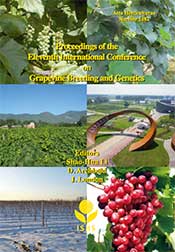Ver ítem
- xmlui.general.dspace_homeCentros Regionales y EEAsCentro Regional Mendoza - San JuanEEA MendozaArtículos científicosxmlui.ArtifactBrowser.ItemViewer.trail
- Inicio
- Centros Regionales y EEAs
- Centro Regional Mendoza - San Juan
- EEA Mendoza
- Artículos científicos
- Ver ítem
Germplasm evaluation of the native cultivar “Torrontes Riojano” (Vitis vinífera L.) collected in the Northwest of Argentina
Resumen
The cultivar ‘Torrontés Riojano’ (Vitis vinifera L.) was derived from a cross of ‘Muscat of Alexandria’ and ‘Criolla Chica’. Its origin was probably not a directed cross in Mendoza Argentina during the colonial period. Related cultivars with common characteristics are called “criollas”. Some are derived from the same cross, and one is a half-sister with a parent in common. ‘Torrontés Riojano’ is a productive and vigorous cultivar, and usually is used to
[ver mas...]
The cultivar ‘Torrontés Riojano’ (Vitis vinifera L.) was derived from a cross of ‘Muscat of Alexandria’ and ‘Criolla Chica’. Its origin was probably not a directed cross in Mendoza Argentina during the colonial period. Related cultivars with common characteristics are called “criollas”. Some are derived from the same cross, and one is a half-sister with a parent in common. ‘Torrontés Riojano’ is a productive and vigorous cultivar, and usually is used to produce dry white wines with distinct ‘Muscat’ flavor. It is spread in the Argentinean northwest wine valleys. Collection trips were made in summer to identify plants with morphologic variations, and others were made during autumn and spring to eliminate plants with viral disease symptoms. Sixty clones were collected from 6 vineyards located in the areas where this cultivar is mostly cultivated, Cafayate (Salta, Argentina) and Chilecito (La Rioja, Argentina). Virus diseases were screened by ELISA tests, and six microsatellites were used to confirm varietal identity: VVMD5, VVMD7, VVMD27, ssrVrZAG 62, ssrVrZAG 79 and VVS2. After that, clones were planted in triplicate in a homogeneous plot. Parameters related to cluster morphology and productivity were measured over 2 growing seasons, 2013 and 2014. The high variability observed in the collection was evidenced through the coefficients of variation. The work is the first contribution of ‘Torrontés Riojano’s germplasm and a starting point to hypothesize about the origin of the variability in this cultivar.
[Cerrar]

Autor
Fuente
Acta horticulturae 1082 : 217-222. (2015)
Fecha
2015
ISSN
0567-7572
Formato
pdf
Tipo de documento
artículo
Palabras Claves
Derechos de acceso
Restringido
 Excepto donde se diga explicitamente, este item se publica bajo la siguiente descripción: Creative Commons Attribution-NonCommercial-ShareAlike 2.5 Unported (CC BY-NC-SA 2.5)
Excepto donde se diga explicitamente, este item se publica bajo la siguiente descripción: Creative Commons Attribution-NonCommercial-ShareAlike 2.5 Unported (CC BY-NC-SA 2.5)

